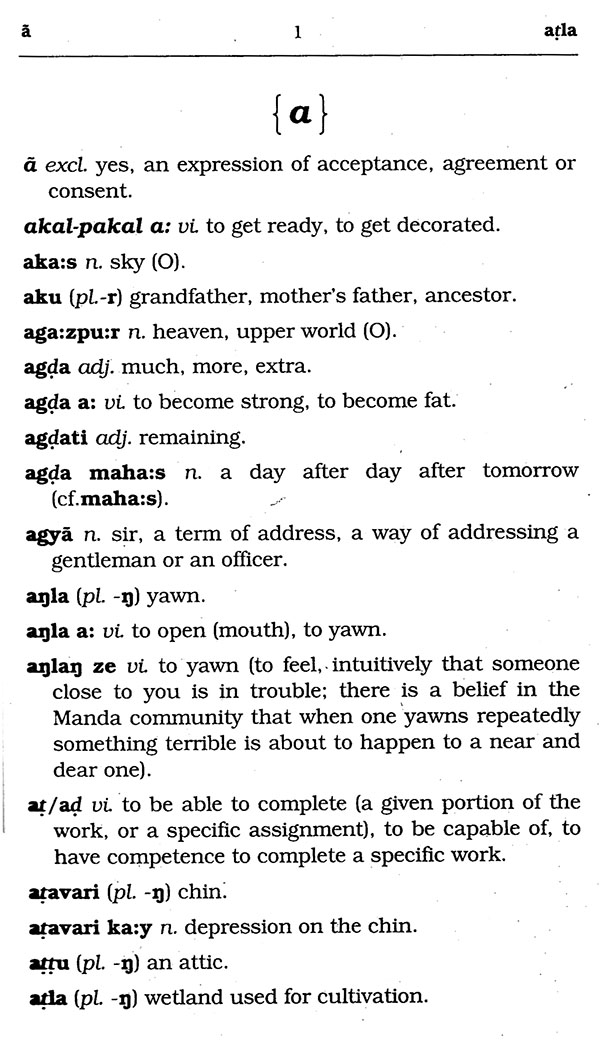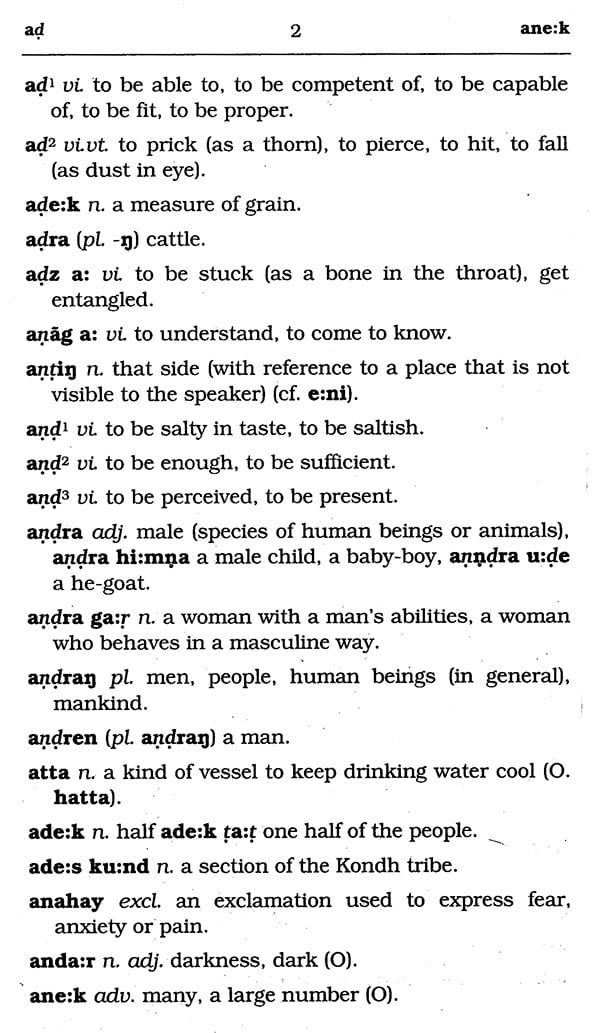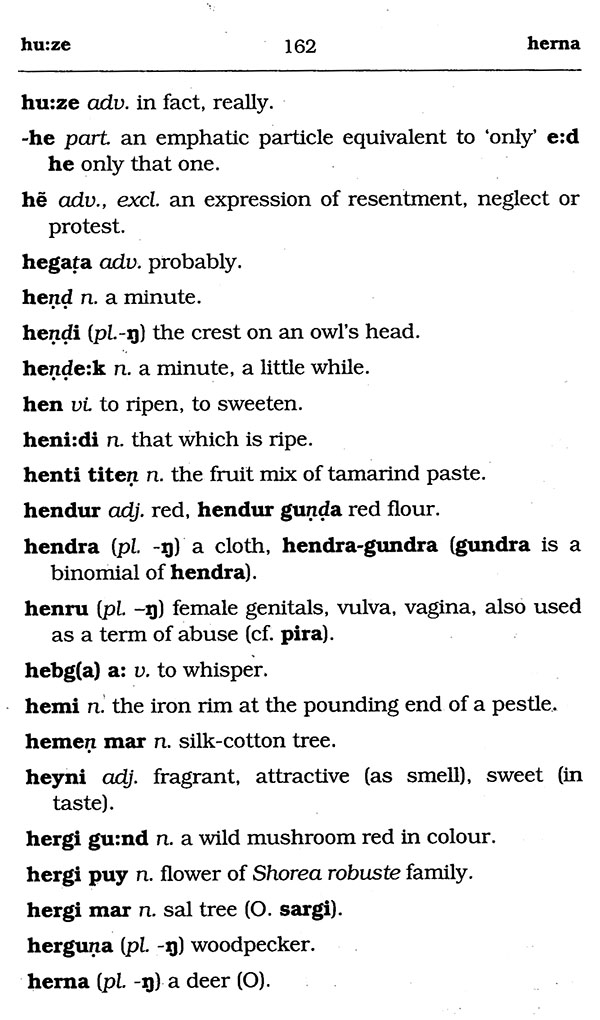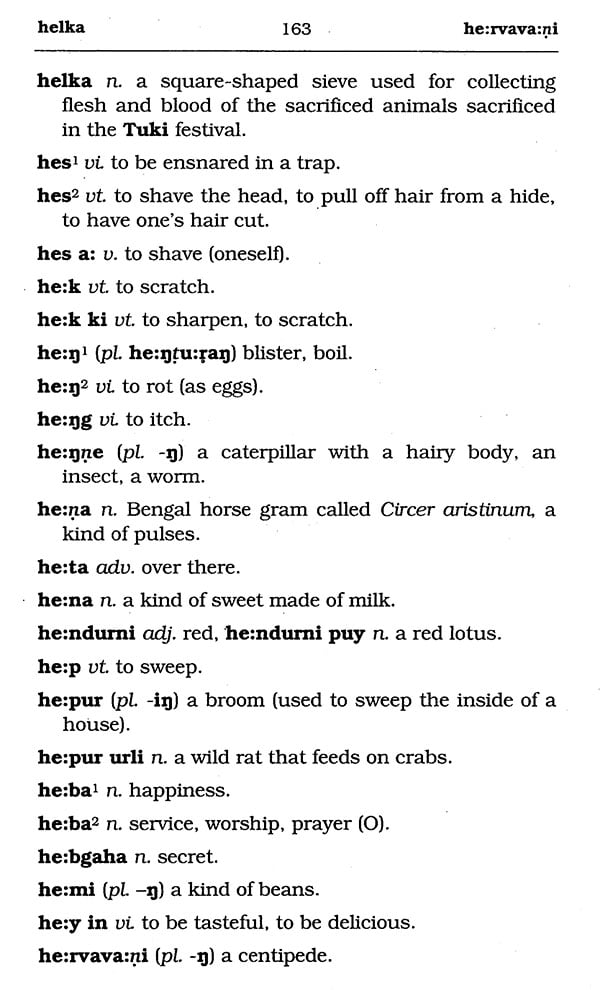
Manda-English Dictionary
Book Specification
| Item Code: | NAX331 |
| Author: | B. Ramakrishna Reddy |
| Publisher: | Central Institute Of Indian Languages, Mysore |
| Language: | Manda |
| Edition: | 2009 |
| ISBN: | 8173421854 |
| Pages: | 164 |
| Cover: | PAPERBACK |
| Other Details | 9.00 X 6.00 inch |
| Weight | 200 gm |
Book Description
The Manda language spoken by a section of the Kondh tribe belongs to the South-Central sub-group of the Dravidian family of languages. The Manda-Kondhs inhabit the highlands of Thuamal Rampur Block of Kalahandi district in Orissa. The Manda-Kondhs are bilingual having proficiency in their mother tongue as well as Oriya. Having a population of about five thousand, the languages of the Kondh community have become endangered under the impact and influence of the major regional languages and their dominance in the visual electronic media.
The Manda-English Dictionary is prepared from material collected during extensive linguistic fieldwork carried out on the language. The dictionary includes the Manda native (Dravidian) vocabulary as well as words borrowed from Oriya. In all, these items signify the tribe's socio- cultural practices, way of life, categorisation of the universe, rituals, festivals, flora, fauna, kinship, interpersonal interactions, relationship with nature and the value systems.
The dictionary would be a valuable aid in teaching, literary education, tribal development activities as well as in providing a distinct identity to the community. Above all, it is a significant step towards the preservation of the Manda language and a valuable research source for scholars.
B. Ramakrishna Reddy is a distinguished linguist, with specialisation in tribal languages and literature. He has conducted extensive linguistic fieldwork on the tribes of central and southern India including the speakers of Kuvi, Manda, Indi- Awe, Gadaba, Irula, Parengi (Gorum), Kharia, Adivasi Oriya and Banjara (Lambadi) languages. He has held academic positions at Annamalai University, Central Institute of Indian Languages, Central Institute of Hindi, Osmania University, P S. Telugu University and Dravidian University. He has been associated with the Adivasi Academy, Tejgadh since its inception.
Prof. Reddy's publications include Kuvi Phonetic Reader (1974), Localist Studies in Telugu Syntax (1986), Kuvi-Oriya-English Dictionary (1995), Kuvi Folk Literature with Oriya and English Translation (2000) and Tribal Lore of South India (2004). He has edited Studies in Dravidian and General Linguistics (1992), Dravidian Folk and Tribal Lore (2001), Agreement in Dravidian Languages (2003), Word Structure in Dravidian (2003) and The Tribal and Minor Dravidian Languages: An International Bibliography (2005).
During the last academic year, the Central Institute of Indian Languages (CIIL) had offered a substantial grant to Bhasha Research Centre for a set of four books which are now ready to be published. These are
- Tribal Literature of Gujarat by Nishaant Choksi
- Manda Oral Literature by B. Ramakrishna Reddy
- Manda English Dictionary by B. Ramakrishna Reddy
- Indigenous Peoples: Responding to Human Ecology by Lachman Khubchandani
Among the books being published, the importance of a dictionary is undeniable. With the advent of literature, words acquired new meanings as well as usage. To help readers to have an entry into the world of unknown words, the publication of dictionaries is essential. Since many tribal regional languages have started producing literature ‘these days, an introduction to all of them from Gujarat is very useful. Similarly, orality keeps the debate on in literary circles, and to that extent the work on Manda oral literature is particularly welcome. The last of these is a treatise by Professor Khubchandani, who has been at the forefront of tribal studies for the last fifty years, and is an untiring crusader for the tribal cause. In that respect, his work on Human Ecology is extremely important.
What are the challenges for a Tribal Languages researcher in India? In many cases the tribal habitats are inaccessible and almost one-third of them still live below the poverty line. Consequently, hunger and prolonged fight with day-to-day adversities take precedence over education as effects of development are either lacking or are sub-standard. Abject poverty of these communities compounds the problem. And yet, they are creative and culturally sensitive and may even turn out to be more civilised than the so-called civil society. The situation has vastly improved after "Tribal Affairs’ received a special focus and a special ministry was set up and the sectoral programmes, such as health, education, poverty alleviation, women & child development etc., are looked after by the concerned Central Ministry that continues to administer its programmes.
CIIL has always been active in the field of tribal and border languages, and is engaged in endangered languages researck these days. This is not something that can be achieved by one institution alone, no matter what its funding for such activities would be. The main dearth is in the human resource that is in plenty with organisations such as Bhasha. This is what makes the collaboration worthwhile. I am sure that research scholars, faculty, government officials as well as common readers would like these books, and will send us their feedback to improve upon these texts in later editions. More importantly, these books are going to be acceptable by all those who are members of these communities. That will give us all a great satisfaction.
Central India is the homeland of many tribal communities whose native languages belong to the Dravidian, Austro-Asiatic or Indo-Aryan family. The Kondh is one such prominent tribe living in parts of Orissa and Andhra Pradesh and speaking a group of Dravidian languages. They are also found, though in fewer numbers as migrant labourers in Chattisgarh, Jharkhand, Maharashtra, West Bengal and Assam.
The name of the tribe under study is written with different spellings such as Kondh, Khond, Khondh, Kandha, Kond or Kondo. Here, the form Kondh is adapted as a representative term. These labels for the tribe are said to be derived from the Telugu (Dravidian) word konda which means ‘mountain’ or hill’. Kandhamal, that is a district in Orissa can be interpreted as a combination of Telugu konda and Proto-Dravidian malat ‘mountain’, providing the meaning ‘hilly region’ and hence ‘hill dwellers or hill tribe’.
Many of the tribal communities in Orissa and adjoining areas are referred to as Parjas, ‘the people’. Accordingly, the Kondhs are known as Kondh Parjas on par with other tribal communities like Pengo Parja, Bondo Parja, Parenga Parja and so on. In the complex multilingual context of India, many ethnic communities may speak a single language as their home language. But in the case of the Kondhs the situation is quite unique for ‘Kondh’ is a generic term standing for a single tribal community that is divided into five linguistic groups depending upon the home language or mother tongue of a particular section. Thus, there are five Kondh languages distributed chiefly, if not exclusively, across the area given here as under:
- Kui — Phulbani (Kandhamal), Boudh and Ganjam districts of Orissa
- Kuvi — Koraput and Rayagada districts of Orissa; Visakhapatnam, Vizianagaram and Srikakulam districts of Andhra Pradesh
- Pengo -— Nowrangpur (Nabarangpur) and partly Kalahandi district of Orissa
- Manda — Kalahandi district of Orissa
- Indi-Awe — Rayagada district of Orissa
These linguistic groups are also called Kui-Kondh, Kuvi- Kondh, Pengo-Kondh, Manda-Kondh by the native speakers whereas the outsiders refer to them collectively as Kondh Parjas.
Manda and other Kondh languages belong to the South- Central sub-group of Dravidian family. The Manda Kondhs live in the highlands of Thuamal Rampur Block in Kalahandi district of Orissa. There are about sixty villages inhabited by the Manda community; the population of each village ranges anywhere from 25 to 300 persons. The total number of Manda speakers as estimated during our visits is between 4,000 to 5,000. The Census of India with effect from 1971 does not record any language that has less than 10,000 mother tongue speakers. Consequently, Manda is not mentioned in the government records. The community is currently living in isolated highlands and retains its distinct mother tongue. But the language has become endangered due to the impact of Oriya, the major inter-group medium of communication. The Manda speakers are bilingual and are fluent in both their home ‘language as well as Oriya.









